Les Trois Escargots
A growing family of snails.
Tuesday, October 31, 2006
Monday, October 30, 2006
The Salar de Uyuni

Eight hours west of Potosi by bus is the single storey town of Uyuni. A crossroads, a market town and the starting point for 3 day trips to the vast salt pan of Salar de Uyuni and surrounding volcanic landscape. In a town with a handful of streets, 24 agencies sell the same trip and it was easy to book ourselves into a Toyota Land Cruiser leaving the next morning with an Australian couple and 2 French guys.
 With Chile so close and Bolivia lacking its own coastline, minerals have long been exported by rail from a huge mine east of Uyuni to the Pacific. Outside town, in the “Train Cemetery”, we looked at the rusting carcasses of steam trains, dumped in the late 70s when diesel locomotives took over. A wit had daubed graffitti on one: “Wanted – mechanic with experience”. We took the obligatory photos and Chriso, our driver, joined the convoy of other Land Cruisers to the village of Colchani.
With Chile so close and Bolivia lacking its own coastline, minerals have long been exported by rail from a huge mine east of Uyuni to the Pacific. Outside town, in the “Train Cemetery”, we looked at the rusting carcasses of steam trains, dumped in the late 70s when diesel locomotives took over. A wit had daubed graffitti on one: “Wanted – mechanic with experience”. We took the obligatory photos and Chriso, our driver, joined the convoy of other Land Cruisers to the village of Colchani.
 Located on the edge of the Salar, the villagers spend 8 hours a day collecting salt which is then dried over a wood fire, crushed and, after iodine has been added to prevent thyroid problems, bagged by hand. At 50p for 25 kg, the margins are tight and a day’s pay for a salt worker is less than 2 pounds.
Located on the edge of the Salar, the villagers spend 8 hours a day collecting salt which is then dried over a wood fire, crushed and, after iodine has been added to prevent thyroid problems, bagged by hand. At 50p for 25 kg, the margins are tight and a day’s pay for a salt worker is less than 2 pounds.
 The Salar, formed by the evaporation of a huge lake into which minerals from the surrounding mountains had leached, covers 12,000 square kilometres and contains 64,000 million tonnes of salt which is up to 12 metres thick in places. Put simply, it is stunningly white. Dazzling. Without sun glasses, you would become salt blind. Two dark lines, the rubber of a thousand Land Cruisers, marked the route and the tyres hummed on the hard surface as we headed to the island of Inca Huasi in the middle of the Salar. Covered in ancient cacti, the views over the salt pan were incredible. An immense blankness, edged by the shadows of distant volanoes, which defied scale and hypnotised us with its lack of reference points.
The Salar, formed by the evaporation of a huge lake into which minerals from the surrounding mountains had leached, covers 12,000 square kilometres and contains 64,000 million tonnes of salt which is up to 12 metres thick in places. Put simply, it is stunningly white. Dazzling. Without sun glasses, you would become salt blind. Two dark lines, the rubber of a thousand Land Cruisers, marked the route and the tyres hummed on the hard surface as we headed to the island of Inca Huasi in the middle of the Salar. Covered in ancient cacti, the views over the salt pan were incredible. An immense blankness, edged by the shadows of distant volanoes, which defied scale and hypnotised us with its lack of reference points.
 After lunch of roasted meat and salad, we drove south and stopped in a small lodging perched on the hillside overlooking the Salar. Built entirely of salt (walls, furniture, beds and floors), it was basic, but cosy and, with earplugs against a group of Irish, I slept soundly.
After lunch of roasted meat and salad, we drove south and stopped in a small lodging perched on the hillside overlooking the Salar. Built entirely of salt (walls, furniture, beds and floors), it was basic, but cosy and, with earplugs against a group of Irish, I slept soundly.
 On the second day, we crossed the railway line and climbed on rocky tracks into a volcanic landscape of fractured lava, vast brown fields of pumice and conical peaks. At the fourth of a series of shallow, salty lakes, we stopped for lunch. Deep pink-coloured flamingos strutted in the water, moving serenely out of reach as the tourists tried to photograph them. It would have been good to have stayed, but the convoy had to roll on and we passed huge rocks carved into surreal shapes by the wind. In late afternoon, we reached Laguna Colorada, a vast lake with islands of white salt and borax, flocks of hundreds of flamingos and water stained read by algae. A wind was howling and the lake felt primordial in the fading daylight.
On the second day, we crossed the railway line and climbed on rocky tracks into a volcanic landscape of fractured lava, vast brown fields of pumice and conical peaks. At the fourth of a series of shallow, salty lakes, we stopped for lunch. Deep pink-coloured flamingos strutted in the water, moving serenely out of reach as the tourists tried to photograph them. It would have been good to have stayed, but the convoy had to roll on and we passed huge rocks carved into surreal shapes by the wind. In late afternoon, we reached Laguna Colorada, a vast lake with islands of white salt and borax, flocks of hundreds of flamingos and water stained read by algae. A wind was howling and the lake felt primordial in the fading daylight.
 We rose the next day at 5am in the darkness to reach the Sol y Manana geysers at dawn. Backlit by the warm morning sun, the clouds of steam were beautifully golden and the landscape a rich yellow. Craters bubbled with grey mud, holes hissed with gas and a sulphurous smell filled the air. The entire region was active and, a few kilometres away, we soaked in natural hot spring while Chriso prepared cake and mugs of sweet, hot chocolate. It was lovely to wash off the grime, dust and sweat of two days on the road.
We rose the next day at 5am in the darkness to reach the Sol y Manana geysers at dawn. Backlit by the warm morning sun, the clouds of steam were beautifully golden and the landscape a rich yellow. Craters bubbled with grey mud, holes hissed with gas and a sulphurous smell filled the air. The entire region was active and, a few kilometres away, we soaked in natural hot spring while Chriso prepared cake and mugs of sweet, hot chocolate. It was lovely to wash off the grime, dust and sweat of two days on the road.
 We dropped the French at the Chilean border and, with the Land Cruiser almost spacious, we headed north for the seven hour journey to Uyuni. The landscape was brutal and barren with only the odd adobe village and herds of llamas giving any clue to human existence. I wanted to store it all in my mind because soon enough we would be back in the bustling madness of La Paz.
We dropped the French at the Chilean border and, with the Land Cruiser almost spacious, we headed north for the seven hour journey to Uyuni. The landscape was brutal and barren with only the odd adobe village and herds of llamas giving any clue to human existence. I wanted to store it all in my mind because soon enough we would be back in the bustling madness of La Paz.
I am rich Potosi, envy of kings
Potosi is the highest city in the world and perhaps the one with the most tragic history. Its location in the middle of the barren altiplano of Bolivia is solely due to Cerro Rico, a conical mountain just to the south. Cerro Rico was the richest source of silver that has ever existed. Initial mining by the Spanish was based on surface extraction and primitive processing methods, but the mining was eventually forced underground as deposits grew scarcer. However, with dams to power machinery, mercury refining and an Inca-based system of compulsory labour (one seventh of the male population of Bolivia were sent annually to the mines), silver production boomed. In 1658, for the Corpus Cristi celebrations, the streets were literally paved in silver. But the silver boom passed and, although Potosi cashed in on the subsequent global increase in tin price, it was the start of a long term decline and Cerro Rico is today mined on a near subsistence basis by cooperatives of miners. Dependant on mining and yet acutely aware that their life expectancy is just 45, they have no choice, but to work underground in extremely dangerous and basic conditions.
Tours of the mines start at the miners’ market on the lower slopes of the mountain. Dressed in wellies, overalls and hard hats, we were shown how green Bolivian dynamite is rolled into a ball and stuffed into a bag of nitrate fertiliser to make a powerful explosive. A gunpowder fuse, burning at 20 cm per minute, completes the bomb. The whole thing costs just over a pound and its purchase (and use) is legal in Bolivia. It was the quickest lesson in terrorism that I have ever had! At the market, we bought coca leaves, explosives and soft drinks for the miners; 96% alcohol as a gift to the gods.
The mine entrance was splattered with llama blood, part of the annual sacrifice to El Tio, god of the underworld. We walked between steel rails for the wagons of ore pushed by sweating men, the lamps on our helmets casting weak pools of yellow light. After twenty minutes, we stooped into a side tunnel and sat on lumps of rock in front of a stone-carved El Tio – a red, horned devil with cigarette and proud erection. Rolando, our guide, explained that the Catholic God has no power underground and that offerings are made to El Tio to protect the miners from cave ins, explosions and dangerous gases. We toasted him with near pure alcohol which burnt my lips and throat.
From the first level, we scrambled down a hole in the floor, twisting between fractured rock, to the hot and dusty second level. Three of our group decided that the dark, caustic and claustrophobic environment was too much and the second guide led them to the surface. Down to five, we crawled onwards, hardly believing that the miners dragged ore through these passages, until we climbed a small gully and talked to a miner making holes in a rock face for dynamite. It would take him at least 4 hours to manually hammer each hole with a steel crowbar. On the third level, we found the ghost of a 13 year boy working with five men and watched him gulp down coca cola, spilling it in dark patches on his t-shirt in his urgency. There are perhaps 2,000 children working in the mines and, with silicosis destroying the lungs of most miners, most would not live to see their grandchildren.
Thursday, October 12, 2006
A Bolivian High
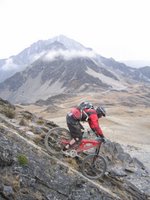
My mind drifted as the Landcruiser, laden with 6 riders, 2 guides and their bikes, rattled its way up the dirt track heading into the heart of the Bolivian Andes. It had been less than 24 hours since I had broken my 3 cardinal riding rules - (1) Never ride in groups, (2) Never ride a hire bike, and (3) Never use a guide. After 15 years of ´doing it myself´, I had finally been forced to give in and, after yesterday´s insanity, I had no regrets.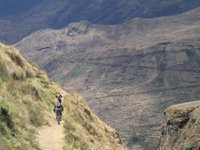 We had left La Paz the previous morning and, during the 4 hour drive, had swapped war stories, sussing out everyone else´s riding ability. Equipped with the hire bike version of the Kona Coiler, all suspension set super soft, there was a faint whiff of alpha-maleism in the back of the truck and the conversation covered crashes, bikes and home trails. After a couple of months´travelling with my girlfriend, it was a real treat to let rip with some good old biking talk.
We had left La Paz the previous morning and, during the 4 hour drive, had swapped war stories, sussing out everyone else´s riding ability. Equipped with the hire bike version of the Kona Coiler, all suspension set super soft, there was a faint whiff of alpha-maleism in the back of the truck and the conversation covered crashes, bikes and home trails. After a couple of months´travelling with my girlfriend, it was a real treat to let rip with some good old biking talk.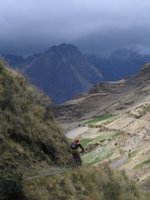 There was the usual faff at the start of the trail (see cardinal rule (1) above) as we checked bikes and bodies, but we were at 4600 metres and there was 2000 metres of vertical height to lose. We had no time to waste. The trail, essentially a donkey track and reminiscent of riding in Las Alpujarras of Southern Spain, dropped into a dry, yellow valley. At first, the valley was wide and we could carve wide lines over dusty turf, getting a feel for the bikes and the spongy front ends (which would later prove invaluable). It was steep, narrow, technical riding and we made swift weight changes as we danced between rocks, taking lines that we would never take on our own bikes. After crossing a river, we dropped onto perfect llama singletrack - packed, dusty and 4 inches wide - which contoured high on the valley side. It was focussed riding with a big drop to the right and we were forced to concentrate, moderate speed, stay positive and ride smoothly. It was an intoxicating mix of fear and excitement. I could have ridden it all day.
There was the usual faff at the start of the trail (see cardinal rule (1) above) as we checked bikes and bodies, but we were at 4600 metres and there was 2000 metres of vertical height to lose. We had no time to waste. The trail, essentially a donkey track and reminiscent of riding in Las Alpujarras of Southern Spain, dropped into a dry, yellow valley. At first, the valley was wide and we could carve wide lines over dusty turf, getting a feel for the bikes and the spongy front ends (which would later prove invaluable). It was steep, narrow, technical riding and we made swift weight changes as we danced between rocks, taking lines that we would never take on our own bikes. After crossing a river, we dropped onto perfect llama singletrack - packed, dusty and 4 inches wide - which contoured high on the valley side. It was focussed riding with a big drop to the right and we were forced to concentrate, moderate speed, stay positive and ride smoothly. It was an intoxicating mix of fear and excitement. I could have ridden it all day.
After a late lunch, the valley widened and the final 2 kilometres of the day will be etched on my mind forever. A set of steep switchbacks, ridden fast with the back wheel sliding speedway style and the front wheel tracking to hold the trail, opened into swooping chicanes before a 4 foot drop off. I was flying and overtook one of the others before nailing an S section with bermed walls to keep the speed. I was in a zone where I was going too fast to worry about crashing and even a last minute mistake before the road which almost saw me flying off a 30 foot drop made no difference. It had been my first riding for several months and it had been unbelieveable. I hoped that the second day would be as good.
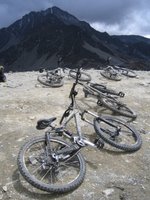 Despite a thunder storm in the night, the second day dawned sunny and the views of 6000 metre snow-capped peaks as the Landcruiser headed ever upwards were stunning. It took 2 hours to reach a small plateau 4700 metres above sea level where we geared up in a chilly wind which seemed to be blowing dark clouds our way. I set off down a serated rock slab which swung into a tight left hand berm before throwing me out onto a barren moonscape of rock with multiple lines. We swerved down to, and over, the road, the suspension soaking up the drop on the other side, before sneaking onto a path through jagged rock. Chad, riding clipped in, lost his front wheel on the greasy rock and sliced through his 3 riding tops before coming to a rest.
Despite a thunder storm in the night, the second day dawned sunny and the views of 6000 metre snow-capped peaks as the Landcruiser headed ever upwards were stunning. It took 2 hours to reach a small plateau 4700 metres above sea level where we geared up in a chilly wind which seemed to be blowing dark clouds our way. I set off down a serated rock slab which swung into a tight left hand berm before throwing me out onto a barren moonscape of rock with multiple lines. We swerved down to, and over, the road, the suspension soaking up the drop on the other side, before sneaking onto a path through jagged rock. Chad, riding clipped in, lost his front wheel on the greasy rock and sliced through his 3 riding tops before coming to a rest.
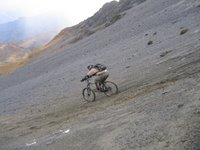
As snow started to fall, we rode a short section of track to a steep scree slope which freaked out the Aussies who had never seen scree or ridden in wet conditions. The Kiwis and I were loving it – it all seemed so familiar. Although everyone was a little nervous to ride something so different, you simply dropped in, pushed your weight back, locked the back wheel as an anchor and feathered the front brake to try to control speed. By gently leaning, you could almost change direction by carving the wheels in the ski like a ski, but it was mostly luck whether you held the line. It was disconcerting to effectively have no control over your speed, but exhilerating to slide the bike down the hillside.
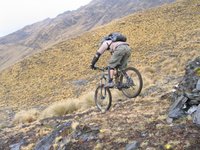 At the bottom, we bounced through some rocky stuff and up the far side of a gully onto a trail just a foot or so from the cliff edge. We skittered over slippery bedrock, the back wheels skidding with the same agression as if they had hit a wet root, and onto an open piece of ground where we cleared two small natural jumps. In the air for the second, I registered the tight, left hand, soily berm too late, but on landing just managed to dig the tyres in and hang on. The left was followed by a right and I had too much speed. The bike slid sideways and still I managed to hang on, though a small part of me knew that it was only a matter of time. The next left was wider and the bike, still out of control, carved through the turn. There was one corner left, a right hander, one more to safety. I came in far too fast, far too tight and the wheels dug in, scrabbling for purchase, but found none and the bike slid out from under me. The others cheered my failure and I lay in the dirt laughing.
At the bottom, we bounced through some rocky stuff and up the far side of a gully onto a trail just a foot or so from the cliff edge. We skittered over slippery bedrock, the back wheels skidding with the same agression as if they had hit a wet root, and onto an open piece of ground where we cleared two small natural jumps. In the air for the second, I registered the tight, left hand, soily berm too late, but on landing just managed to dig the tyres in and hang on. The left was followed by a right and I had too much speed. The bike slid sideways and still I managed to hang on, though a small part of me knew that it was only a matter of time. The next left was wider and the bike, still out of control, carved through the turn. There was one corner left, a right hander, one more to safety. I came in far too fast, far too tight and the wheels dug in, scrabbling for purchase, but found none and the bike slid out from under me. The others cheered my failure and I lay in the dirt laughing.
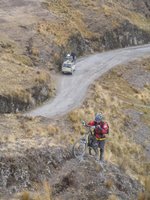 Six kilometres on the dirt road brought us to a small hump, a knackering push at altitude, from where we enjoyed the best section of riding in the entire trip. It was a landscape of turf, gullies, mounds, boulders, scrub and drops. I followed James, the guide, as he rocketed on his own line. Carving into gullies, we flew up sidewalls and pumped up small inclines into the next natural halfpipe. We flicked through tight singletrack, bracnhes brushing our bodies, before James stepped up a gear. Drops, kickers over small ridges, hard cornering and full speed air. I rode the best that I have ever ridden. It was the perfect combination of speed, air and technical cornering.
Six kilometres on the dirt road brought us to a small hump, a knackering push at altitude, from where we enjoyed the best section of riding in the entire trip. It was a landscape of turf, gullies, mounds, boulders, scrub and drops. I followed James, the guide, as he rocketed on his own line. Carving into gullies, we flew up sidewalls and pumped up small inclines into the next natural halfpipe. We flicked through tight singletrack, bracnhes brushing our bodies, before James stepped up a gear. Drops, kickers over small ridges, hard cornering and full speed air. I rode the best that I have ever ridden. It was the perfect combination of speed, air and technical cornering.
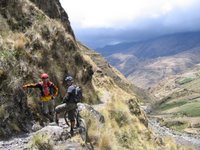
At the road, we regrouped and then flew down twisty, fast singletrack between trees and boulders. It was an invitation to accelerate and we pushed hard, driving through corners, looking ahead. It was perfect reactive riding. We blasted out of the scrub onto an small open plain where I rode 3 abreast with James and Stuart, jumping ditches, flying off kickers before we funnelled into a loose track with off camber turns. We were losing height fast and soon enough we reached a small village from where we rode donkey tracks, the ridges of irrigation channels and open fields. In a rock staircase somewhere in the middle, I caught my front wheel and went over the bars, landing on my head and opening a wound on my shoulder, but it made no difference. The last two days`riding had been varied, demanding, fast, technical and in remote, beautiful scenery. As we reluctantly loaded the Landcruiser for the 4 hour drive back to La Paz, we reflected that we had been privileged to ride in Bolivia and I don`t think that I was alone in hoping that one day I will return.
Isla del Sol

The Incas believed that the sun and the moon first rose from a Sacred Rock on the Isla del Sol in the middle of Lake Titicaca. This belief made it the centre of the most important pilgrimage in the Inca empire and, though the Incas have long gone, we decided that we should see for ourselves the Island of the Sun.
We left Copacabana (see Albane´s blog entry below) with full rucsacs and bodies weakened by too may four course, 30p lunches in La Paz. We walked a dirt track north accompanied for some of the way by Javier, a Bolivian agricultural advisor (as he said), and he told us that he had never seen the sea. We told him about the Atlantic coastline of Europe and surprised him by saying that it was easier (and cheaper) to come to Bolivia by plane than by boat. He left us at the bottom of a steep Inca paved road which took us to the village of Titicacha where we sat and watched the local football derby with fried egg sandwiches. The bumpy pitch reduced all players to the same skill level and it was a miracle that the Yellows managed a last minute winner. The referee blew for full time as the bus arrived - public transport taking precedent over the normal 90 minutes.
We overpaid a man with a boat for the trip to the island and arrived in the early afternoon on a terraced island seemingly deserted. But we didn´t mind and sat on a small hill watching the blue stretch to the horizon and trying to make sense of the serpent-like currents etched on the water´s surface. As the sun set, we pitched the tent amongst scrub, rocks and sheep tracks. To the east, we could see the ice and snow of the Illampu massif warm in the orange light and to the west, the sun flickering and changing the water from blue to purple to black.
The next morning, it seemed only right to welcome the sun rise and Albane did a series of sun salutations, a yoga sequence, to cement our places in the island´s fabric. We headed north after breakfast and spent the day walking the coastline (as we were now thinking of it). We saw Aymaran couples, withered by the sun, walking their sheep and pigs to the marshy bays where grass managed to grow; white and black caracaras, a type of hawk, wheeling over the ridges; the red star flowers of squatting cactii; and views of islets scattered around the main island. In the late afternoon, we reached the Sacred Rock, a remarkably unispiring piece of red sandstone, and the guardian pointed out two impressions in the bare rock called the Footprints of the Sun. It was a stunning day´s walking and it ended in a chilly northerly on a bay where we pitched the tent. An inanely grinning man turned up with a young boy as darkness fell and his odd behaviour left us spooked. Neither of us slept well.
At 5am the next morning, a storm broke and long rumbles of thunder, like burning fuses strung across the sky, deterred us from an early start. But the rain was short-lived and we were on the track with the locals by eight. Kids on their way to school in white labatory coats smiled "Hola!" and we were passed by old women driving their donkeys. It was pleasant walking, the water always in view, and by midday we had reached the main village and boat dock. After the usual scrum to sell us tickets on boats that would leave "pronto", we settled down for a few hours´wait evntually leaving on the locals´boat and chugging our way south in the late afternoon sun, under the towering bluff of El Cavalrio and into Copacabana where we toasted the sunset from a bar with cold Negra beer, a sweetened stout.
Thursday, October 05, 2006
Copacabana

Plage, peau dorée par un soleil puissant, musique brésilienne pour faire bouger des corps parfaits. Ça fait rêver, non? Ça peut mais ……….
Copacabana est aussi un petit village Bolivien a 3840 m d’altitude au bord du Lac Titica qui est aussi connu que la plage de Copacabana grâce à sa vierge qui protège les voitures et leurs passagers.
 Huw et moi y sommes arrivés un samedi matin. Le village semblait très animé de part les bus bondés de touristes qui s’y arrêtent en route pour La Paz et part les micros ou collectivos transportant les locaux. Après avoir trouvé une chambre avec vue sur le lac Titicaca pour 7 Euros à l´hôtel Colonial, nous sommes descendus jusqu’au bord du lac pour trouver tous les activités balnéaires de chez nous: kayaks à louer, petites barques, bateaux à moteur avec ou sans skipper, excursions jusqu’aux iles (isla del Sol y isla de la Luna) ou les iles flottantes à la différence près que les loueurs ne portent ni shorts ni T-shirt de marque. Ils sont en costume traditionelle et se protègent comme ils peuvent du soleil. Bien que ces activités semblent destinées aux touristes, nous n’avons pas vu un seul étranger sur les bateaux. Peur de tomber dans cette eau à dix degrés ou pas sûrs de la sécurité des bateaux, ces derniers sont plutôt dans un des nombreux restaurants longeant la plage et dégustent una trucha a la criolla ou a la plancha accompagnée d’un verre de Simba dont la couleur varie du vert au jaune fluo.
Huw et moi y sommes arrivés un samedi matin. Le village semblait très animé de part les bus bondés de touristes qui s’y arrêtent en route pour La Paz et part les micros ou collectivos transportant les locaux. Après avoir trouvé une chambre avec vue sur le lac Titicaca pour 7 Euros à l´hôtel Colonial, nous sommes descendus jusqu’au bord du lac pour trouver tous les activités balnéaires de chez nous: kayaks à louer, petites barques, bateaux à moteur avec ou sans skipper, excursions jusqu’aux iles (isla del Sol y isla de la Luna) ou les iles flottantes à la différence près que les loueurs ne portent ni shorts ni T-shirt de marque. Ils sont en costume traditionelle et se protègent comme ils peuvent du soleil. Bien que ces activités semblent destinées aux touristes, nous n’avons pas vu un seul étranger sur les bateaux. Peur de tomber dans cette eau à dix degrés ou pas sûrs de la sécurité des bateaux, ces derniers sont plutôt dans un des nombreux restaurants longeant la plage et dégustent una trucha a la criolla ou a la plancha accompagnée d’un verre de Simba dont la couleur varie du vert au jaune fluo. Le ventre bien plein, nous avons longé l’esplanade pour s’impreigner de l’ambiance estivale. C’est la première fois que nous observions des locaux super détendus s’approchant de l’eau timidement tout en criant de joie, jouant au foot en famille ou buvant de l’alcool en plein après-midi. D’ailleurs, un Bolivien un peu saoul nous a proposé un verre de bière pour célébrer le marriage de ses amis. Je crois qu’il espèrait que nous devenions les “padrinos” (parrain-marraine) des futurs enfants. En Bolivie comme au Pérou la tradition veut que le parrain et la marraine paient non seulement le baptême mais aussi l’éducation. Nous avons refusé poliment le verre d’alcool.
Le ventre bien plein, nous avons longé l’esplanade pour s’impreigner de l’ambiance estivale. C’est la première fois que nous observions des locaux super détendus s’approchant de l’eau timidement tout en criant de joie, jouant au foot en famille ou buvant de l’alcool en plein après-midi. D’ailleurs, un Bolivien un peu saoul nous a proposé un verre de bière pour célébrer le marriage de ses amis. Je crois qu’il espèrait que nous devenions les “padrinos” (parrain-marraine) des futurs enfants. En Bolivie comme au Pérou la tradition veut que le parrain et la marraine paient non seulement le baptême mais aussi l’éducation. Nous avons refusé poliment le verre d’alcool. Le lendemain matin, dimanche, nous étions sûrs de trouver les croyants à faire la queue devant la basilique pour que l’un des nombreux prêtres benisse leur nouvelle voiture. Non seulement ils étaient là fiers de leur nouvelle acquisition ( voiture personelle, bus, camion de transport, camionette de travail) mais ils la décoraient des couronnes et gerbes de fleurs fraîches vendues par les artisans. Une fois la voiture décorée, la famille y dépose devant des voitures miniatures, des faux billets, des médailles et une bouteille de vin mousseux. Elle attend le prêtre patiemment et enfin, après une petite messe, celui-ci benie la famille du propriétaire, le moteur et l’intèrieur de la voiture. Ensuite, des pétales de fleurs sont jetés sur la voiture bénie et le propriétaire la bénie à son tour avec le vin. La famille passera la journée a célébrer cet évenement avant de rentrer chez elle.
Le lendemain matin, dimanche, nous étions sûrs de trouver les croyants à faire la queue devant la basilique pour que l’un des nombreux prêtres benisse leur nouvelle voiture. Non seulement ils étaient là fiers de leur nouvelle acquisition ( voiture personelle, bus, camion de transport, camionette de travail) mais ils la décoraient des couronnes et gerbes de fleurs fraîches vendues par les artisans. Une fois la voiture décorée, la famille y dépose devant des voitures miniatures, des faux billets, des médailles et une bouteille de vin mousseux. Elle attend le prêtre patiemment et enfin, après une petite messe, celui-ci benie la famille du propriétaire, le moteur et l’intèrieur de la voiture. Ensuite, des pétales de fleurs sont jetés sur la voiture bénie et le propriétaire la bénie à son tour avec le vin. La famille passera la journée a célébrer cet évenement avant de rentrer chez elle. Pour les Boliviens, Copacabana est l’endroit où ils verront la mer (l’eau) et où ils pourront tremper leurs pieds pour la première fois de leur vie. C’est la destination idéale pour les jeunes de La Paz, les familles et les fervents catholiques.
Pour les Boliviens, Copacabana est l’endroit où ils verront la mer (l’eau) et où ils pourront tremper leurs pieds pour la première fois de leur vie. C’est la destination idéale pour les jeunes de La Paz, les familles et les fervents catholiques.
Cusco (or Inca Inc.)

After the jungle, we did the usual things in Cusco - washing clothes that had been damp for 9 days, enjoying hot showers - as far as that is possible with the so-called South American Frankenstein showers (the electrical element is attached to the water pipe and turning on the tap gives you a mild shock), and visiting some of the numerous Inca ruins.
Just north of Cusco is the Inca fortress of Sacsayhuaman. Protected on three sides by steep cliffs, the Incas built a three tiered set of ramparts to protect the fourth side. Composed of rocks, some of which have been dragged 30 kilometres to the site and the heaviest of which weighs 300 tonnes, the ramparts stretch 600 metres and remain largely intact even today. The stonework took 100 years to complete (approximately the period of the Inca´s huge South American empire) and is mortarless - the stones carved so well that they simply fit together with no gaps.
 However, despite the Incas´ efforts, the Spanish conquistadors stormed the fortress and slaughtered the Incas. Weakened by civil war and a small pox plague that had killed a third of the native population, the Incas stood no chance against the steel blades and cavalry of the Spaniards.
However, despite the Incas´ efforts, the Spanish conquistadors stormed the fortress and slaughtered the Incas. Weakened by civil war and a small pox plague that had killed a third of the native population, the Incas stood no chance against the steel blades and cavalry of the Spaniards.Having warmed up on Sacsayhuaman, we were ready for Machu Picchu and for a couple of days abandoned all pretences of being "independent travellers" and became "tourists". [I could digress on a consideration of the differences (if any) between these two categories, but I would need a beer and a sense of humour to write anything remotely worth reading and right now I have neither.]

We took the train from Cusco at 6am (in the backpacker class) and to our surprise it rattled uphill through the suburbs, gaining height by simply driving into a dead end, reversing direction and taking another piece of track. In such a manner, we zig-zagged our way out of Cusco and onto an agricultural plain populated by cattle, children on bikes and solitary women watching dirty flocks of sheep. The train, full of white faces, passed through towns - literally down the main street with nothing more than liberal use of the air horn to avoid collisions - and eventually into an ever-narrowing valley. We sat, glued to the window, as the valley closed in, the mountains steepened and the vegetation took control. Hidden somewhere in this had been Machu Picchu, until its "scientific discovery" by Hiram Bingham, an American, and its subsequent development into the most famous tourist site in Peru.
 We arrived at Aguas Calientes, the Wild West town that acts as a transport hub for the site, and dumped our kit in a hostel before walking the train track out of town to a small flight of steps that disappeared into the jungle. Hopefully, this trail would lead us to the summit of the sacred mountain of Putukusi. For the first half hour, we climbed 100 metre ladders bolted to cliff faces - not an Inca design, but certainly effective in gaining height. The ladders led to a col and then a series of steps (half an hour’s worth of a non-stop Step class) brought us to the summit and a stunning view across the valley of Machu Picchu clinging to a small ridge, snow-capped mountains in the background. We sat for a long time contemplating the site before descending in heavy drops of rain to the town and a rather tepid bath in the sulphury, brown hot springs.
We arrived at Aguas Calientes, the Wild West town that acts as a transport hub for the site, and dumped our kit in a hostel before walking the train track out of town to a small flight of steps that disappeared into the jungle. Hopefully, this trail would lead us to the summit of the sacred mountain of Putukusi. For the first half hour, we climbed 100 metre ladders bolted to cliff faces - not an Inca design, but certainly effective in gaining height. The ladders led to a col and then a series of steps (half an hour’s worth of a non-stop Step class) brought us to the summit and a stunning view across the valley of Machu Picchu clinging to a small ridge, snow-capped mountains in the background. We sat for a long time contemplating the site before descending in heavy drops of rain to the town and a rather tepid bath in the sulphury, brown hot springs. At dawn the next day, we were sat on the agricultural terraces of Machu Picchu watching sun rise over the site. It is difficult to describe the inexorable movement of the sun as it worked its way over the ruins, deep shadows being cast, a warm orange glow on the stonework. It was worth the effort of visiting for the sunrise alone, but we then walked through the walls, temples and chambers alone for twenty minutes before setting off on the trail to the top of Waynupicchu, the unmistakeable pyramid-shaped peak overlooking the site. Steep and unrelenting, we passed a group of complaining Northerners, some wise-cracking, but knackered Canadian and a couple of Americans to reach the summit. Far below, we could see the plaza of Machu Picchu, overrun with tourists regretting their lie in, and the river which curves in a U shape around the ridge on which Machu Picchu sits.
At dawn the next day, we were sat on the agricultural terraces of Machu Picchu watching sun rise over the site. It is difficult to describe the inexorable movement of the sun as it worked its way over the ruins, deep shadows being cast, a warm orange glow on the stonework. It was worth the effort of visiting for the sunrise alone, but we then walked through the walls, temples and chambers alone for twenty minutes before setting off on the trail to the top of Waynupicchu, the unmistakeable pyramid-shaped peak overlooking the site. Steep and unrelenting, we passed a group of complaining Northerners, some wise-cracking, but knackered Canadian and a couple of Americans to reach the summit. Far below, we could see the plaza of Machu Picchu, overrun with tourists regretting their lie in, and the river which curves in a U shape around the ridge on which Machu Picchu sits.
We headed down from the summit to the Temple of the Moon - the Inca place of worship for the part of their world that was underground - and imagined the scenes that had taken place in the cave under the huge overhanging rock with carved stone throne at its entrance. Three hours’ walking led back to the main site and we inspected some of the ruins in more detail before taking the bus back to Aguas Calientes and the 4pm train back to Cusco.
We had had mixed feelings about visiting Machu Picchu - the blatant commercialisation and touristification making us uncomfortable about joining the masses - but it was worth it many times over. It was an incredible piece of architecture set in the most amazing steep and remote location with a real feeling of history.
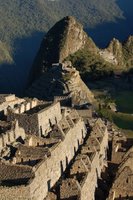
Back in Cusco, we packed and headed east to Lake Titicaca and Bolivia.


